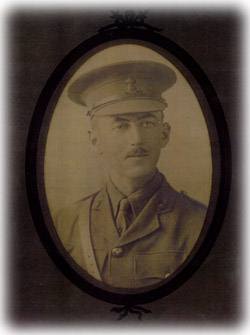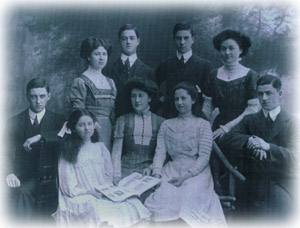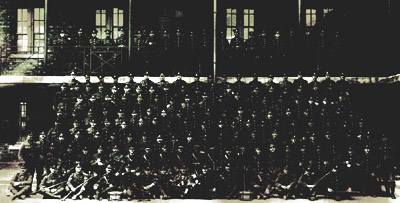
A portrait of Lieutenant Robert Stanton, 6th Battalion, Royal Dublin Fusiliers.
Corkman Robert Stanton followed in his father’s footsteps and studied Law at Trinity College, Dublin. He won the prestigious Trinity Gold Medal and graduated in 1907 aged 21. Robert returned to Cork where he spent five years working in his father’s legal practice.
A dutiful son, Robert obeyed his father’s wishes and did not marry the girl he loved, on the grounds that, ‘Such a marriage would not be sound from a health point of view’. However, Robert did leave the firm and practiced Law in Clones between 1912 – 14.
Trinity had its own army Officer Training Corps, of which Robert was a member. In September 1914, Robert received his commission as 2nd Lieutenant of the 6th Battalion, Royal Dublin Fusiliers. Attached to the 10th Irish Division, Robert’s Battalion were dispatched to the Dardanelles.
Battalion attached to 33rd Brigade (General Maxwell): Moved from beach about 02:30 to Hill 50. ‘A’ Coy detached to support the right flank of the Brigade. Battalion ordered to support firing line near Ali Bey Chesnye 105-11-8.Officers killed, Lt Doyle, wounded, believed killed 2nd Lt Stanton, 2nd Lt Mc Garry, wounded and missing, Major Jennings. Wounded Capt. Luke, Capt. Carroll, Lt Martin, 2nd Lt Carter, 2nd Lt Mortimer, 2nd Lt O’Carroll, missing, Lieut. Clery, killed, wounded, missing, other ranks 259.

The Stanton family in 1910: back row from the left – Alice, George, Jack and Molly; front row – Robert, Ina, Bessie, Sybil and Tom. George and Tom were twins who both studied medicine. Robert and George both died in the war, but Tom and Alice survived their war service.
This extract from the war diary of the 6th Battalion the Royal Dublin Fusiliers is dated August 9th 1915:
Stanton Family Photogtaph
The Stanton siblings – a family portrait taken in Cork in 1910.
The 6th Battalion of The Royal Dublin Fusiliers was attached to the 30th Infantry Brigade of the 10th (Irish) Division. This was one of the new Divisions comprised of volunteers who joined the Service Battalions of the regular Irish Regiments.
Military training of the time was woefully insufficient to prepare the men for what they faced. On the 27th of June 1915, the 10th (Irish) Division received orders to ‘hold itself in readiness for service in the Dardanelles.’
On the 5th of July 1915, as the 10th (Irish) Division set sail from England, some of the men in the ranks sang ‘God Save Ireland.’ Bad planning had resulted in the Division losing some of its fighting units before departure. The Irish Division called at Malta and Alexandria before arriving at Mudros Harbour on the Island of Lemnos in the Aegean Sea.
The Dublin Fusiliers had already been involved in heavy fighting on the 25th of April at Cape Helles at the mouth of the Dardanelles.
This is where the famous Collier ship, The River Clyde, landed the Dublins, Munsters and the Hampshires on the beaches at Cape Helles. The tragic slaughter at Helles ended in stalemate and General Sir Ian Hamilton decided to land elsewhere on the peninsula, choosing Suvla Bay.
After almost a month at sea, the 6th Battalion of the Royal Dublin Fusiliers arrived off the southern end of the Dardanelles peninsula from the Aegean island of Mitylene, August 6th, 1915. Early in the afternoon, the 6th Battalion of the Dubs boarded fishing trawlers and channel steamers for the final approach. At sunset, they steamed northward along the coast, passing Achi Baba and Anzac Cove.
Robert was killed in an attack within two days of landing at Sulva Bay and his body was never recovered. The woman his father refused to let him marry on the grounds of her family health died aged ninety-two, having never married.
Dawn on August 7th, saw the 6th and 7th Dubs Battalions anchored to the south of Nibrunesi Point. Disembarkation on Beach C began at 05:30 and the men were met with a Turkish artillery barrage.
It was not until noon that the men reached the rendezvous point at Lala Baba. In taking Chocolate Hill and Green Hill (Hill 50), the famous ‘D’ Company of the 7th Dubs, The Pals, earned their reputation for bravery. At 7pm on the 7th of August, nearly twelve hours after they had landed, the 7th Dubs along with the 6th Inniskillings, the 5th and 6th Royal Irish Fusiliers (The Faughs) achieved their objective at considerable cost.
Kept in reserve, the main duty of the 6th Battalion of the Dubs was to bring water from the beaches up to the men on Chocolate and Green Hills. The same day, the Munsters were attacking Kiretch Tepe Sirt to the north of Suvla Bay.

In the above photo, Lieutenant Robert Stanton can be seen as the 9th man in from the left-hand side of the 1st sitting row (not the bandsmen). It is estimated that three quarters of the men in this photograph were either killed or wounded at Suvla Bay between the 7th and the 15th of August 1915.
That night, the 31st Brigade made camp on the three miles of hills they had captured. The Corps Commander, General Sir Ian Hamilton rested the troops the following day. On Monday the 9th of August he decided to attack the high ground behind the village of Anafarta Saghir with the 11th Division and part of a newly landed Territorial 53rd Division. General Hill chose the 6th Royal Irish Fusiliers and the 6th Royal Dublin Fusiliers under the command of Brigadier General Henry Haggard for the assault.
Their objective was Scimitar Hill (Hill 70), which was the culminating ridge of a spur running to the north east of Chocolate Hill and the village of Anafarta Saghir.

At down on the 7th of August 1915, the 6th and 7th Battalion Royal Dublin Fusiliers landed at “C” Beach.
The Turks were well prepared for this assault and although the Dubs and Faughs gained some ground, the Turks launched repeated counter attacks and a series of bush fires threatened the wounded with being burned to death. Lieut. Robert Stanton was killed in this battle and, as his body was not recovered, it is likely that it was consumed by one of the bush fires.
Hill 50, or Green Hill was already in Allied control. This account indicates that Robert and his men were moved from the Beach up to the point of attack to prepare for the assault on Hill 70.
Robert was twenty eight years of age when he died. On the 16th of August 1915 Robert’s father John A., received a telegram from the Secretary of The War Office.
J Stanton 47 South Mall Cork: